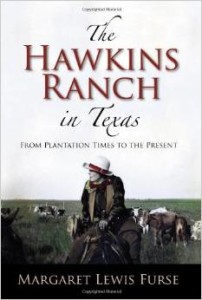Margaret Lewis Furse, in writing about her family ranch in Matagorda County, has created a unique entry in the traditional agricultural histories often published by university presses. Ms. Furse, traces the evolution of the Hawkins Plantation from its beginning in 1846 to a working ranch after the Civil War and on to an investment portfolio in 1991. Along the way she interjects two very interesting and relative concepts. What is the significance of place relevant to agricultural use over several generations? How did the role of women influence the direction the Hawkins family ranch followed?
When James Boyd Hawkins, his wife Ariella, six of the nine children born to the couple, and thirty-four slaves arrived in Texas they were prepared to operate a sugar plantation. While it was difficult, tedious, labor-intensive work, the plantation thrived until June 1865 when news of the Emancipation Proclamation reached Texas. With no bonded labor, Hawkins turned to former slaves who chose to remain with the family. At the same time, Hawkins and his son Frank transformed the sugar plantation into a working cattle ranch.
James Boyd Hawkins was a prosperous cattleman and merchant who at the time of his death in 1896 passed the management of the ranch to his son. Along the way the younger Hawkins and his brother-in-law established a bank in the new town of Bay City. Shortly before his father’s death, Frank Hawkins lost his young wife in childbirth leaving him with five young children under the age of eight. Then five years later, Frank Hawkins died. The five children went to Bay City to live with their uncle, the banker, and his family.
But the place, the ranch remained in the hands of the five children, albeit under the care of their guardian. When the youngest sibling reached the age of majority, the five requested they be made joint managers of the family property. The four girls took an active lead and became known as the Young Lady Ranchers following the goals of their former grandmother Ariella Hawkins. At a time when women were often shunted to the parlor for card games and pursuing progressive ideas, the four Hawkins girls continued to uphold the family tradition under such adverse conditions as the Great Depression.
Only two of Frank Hawkins’ children had children of their own. As the young lady ranchers aged, the management of the ranch was taken over by Frank Hawkins Lewis, the author’s brother. His sister and cousins retained a strong interest in the ranch. By 1991 the ranch was incorporated with all adult heirs sitting on the Board of Directors.
Ms. Furse debates the importance of place in the continuance of the ranch. The young lady ranchers chose to preserve the old ranch house at a time when cash was not easily available for such endeavors. Other decisions made by the family were tinged with a regard for the preservation of the historic ranch. Place is definitely important, but will it remain that way as younger generations with fewer ties to place join the board?


Random question; How Can I find an “inventory of slaves” owned by J.B. Hawkins and/or his Brother John Davis Hawkins? – I think my family was part of their ‘property’ – but cannot find a list of names of their slaves. Thanks so much if you can provide any help.
https://familysearch.org/wiki/en/Matagorda_County,_Texas_Genealogy#Newspapers